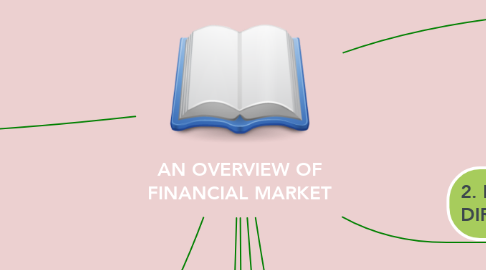
1. 7. TYPES OF FINANCIAL INTERMEDIARIES
1.1. Deposit-type institution
1.2. Contractual savings institution
1.3. Investment funds
1.4. Other types of financial intermediaries
2. 6. FINANCIAL INTERMEDIARIES AND INDIRECT FINANCING
2.1. Financial intermediation
2.2. Indirect financing
2.2.1. Characteristics
2.2.2. Examples
2.3. The economic of financial intermediaries
2.4. Transaction cost
2.4.1. Definition : All fees and commissions paid when buying or selling securities.
2.4.2. Characteristics
2.5. Asymmetric information
2.5.1. Adverse selection
2.5.2. Moral hazard
2.6. Protect against market failures
2.6.1. With respect to adverse selection
2.6.2. Moral hazard problems occur after the money is lent
2.7. Types of intermediation services
2.7.1. Denomination Divisibility
2.7.2. Currency Transformation
2.7.3. Maturity Flexibility
2.7.4. Credit Risk Diversification
2.7.5. Liquidity
3. 8. THE RISKS FINANCIAL INSTITUTIONS MANAGE
3.1. Credit risk
3.1.1. Definition
3.1.2. How to manage the credit risks of loans or investments in debt securities?
3.2. Interest rate risk
3.2.1. Definition
3.2.2. The example of how interest rate risk adversely affects a financial institution’s earnings?
3.2.2.1. Saving industry
3.2.2.2. Loan industry
3.3. Liquidity risk
3.3.1. Definition
3.3.2. Examples
3.3.2.1. Life insurance company
3.3.2.2. Bank
3.3.2.3. Thrifts
3.4. Foreign exchange risk
3.4.1. Definition
3.5. Political risk
3.5.1. Definition
3.5.1.1. Domestic
3.5.1.2. Internation
4. 9. REGULATION OF THE FINANCIAL SYSTEM
4.1. Consumer protection regulation
4.1.1. Reason: To protect consumers and small-business owners from the complexities of finance and its arcane decision-making rules
4.1.2. Some high-level views
4.1.2.1. The Home Mortgage Disclosure Act of 1975 and the Community Reinvestment Act of 1977
4.1.2.2. The Truth-in-Lending Act of 1968
4.1.2.3. Other laws
4.2. Stabilizing the financial system
4.2.1. What happen if the financial system occur crisis?
4.2.1.1. In financial crisis, a bank panic => the simultaneous failure of many banks => the decline in economic activity => creates doubts in the minds of people regarding the safety and soundness of the financial system
4.2.1.2. When the financial system collapses => loss to wealth and difficult or impossible to obtain loans => unemployment, reduce the demand, domestic gross national product declines… => a recession by the collapse of the financial system
4.3. Historical view of bank regulation
4.3.1. Bank regulations in the United States were out of date
4.3.1.1. The so-called competition among regulators for financial institutions to regulate resulted in regulation at the lowest common denominator, thus weakening the regulatory system
4.3.1.2. Regulations did not focus enough on safety and soundness of the fi nancial system
4.3.1.3. The regulations failed to account fully for the impact of technology on innovation and development of new financial products
4.4. Regulatory reform
4.4.1. Restoring American Financial Stability Act of 2010 (changed by President Obama)
4.4.1.1. It dramatically revamp everything, from the operation of large, complex bank-holding companies to consumer protection.
4.4.1.2. It focuses on the safety and soundness of the fi nancial system and the protection of consumers when they transact with fi nancial services firms
5. Direct financing example
6. 1. FINANCIAL SYSTEM
6.1. Finacial system
6.1.1. Financial market
6.1.1.1. Stocks, bonds, future contracts
6.1.1.2. Involve huge dollar amounts
6.1.1.3. Incredibly risky and newsworthy
6.1.2. Financial institution
6.1.2.1. Firms: Invest fund in financial assets (bussiness loans, stocks, bonds)
6.1.2.2. Dominate financial system worldwide
6.2. Budget position
6.2.1. A balance budget: Income = Expenditure
6.2.2. A surplus budget: Income > Expenditure (Surplus spending units: SSUs)
6.2.3. A deficit budget: Expenditures > Revenue (Deficits spending units: DSUs)
6.3. How fund flows through finacial system
6.3.1. Direct financing: funds flow directly through financial market: SSUs - Financial Market - DSUs
6.3.2. Indirect financing (financial intermediation): funds flow indirectly through financial market: SSUs - Financial Market - DSUs
6.4. Financial Claims
6.4.1. Liabilities for borrowers (DSUs) = Assets for lenders (SSUs)
7. 2. FINANCIAL MARKETS AND DIRECT FINANCING
7.1. Overview of investment banking
7.1.1. Investment banking firms: help businesses in financial markets
7.1.2. Large money center banks: large commercial banks usually located in major financial centers
7.2. Investment banking services
7.2.1. Bring new securities to markets
7.2.1.1. Help firms bring their new debt or equity securities to market
7.2.1.2. Tasks involve
7.2.1.2.1. Origination
7.2.1.2.2. Underwriting
7.2.1.2.3. Distribution
7.2.2. Trading and Brokerage Services
7.2.2.1. Brokers
7.2.2.2. Dealers
8. 3. TYPES OF FINANCIAL MARKETS
8.1. Primary and Secondary markets
8.1.1. Primary markets
8.1.2. Secondary markets
8.1.3. Terms
8.1.3.1. Marketability
8.1.3.1.1. Does not carry the same implication as liquidity
8.1.3.1.2. A security’s marketability depends on the cost of trading and the search for information
8.1.3.2. Liquidity
8.1.3.2.1. Implies that when a security is sold, its value will be preserved
8.2. How consumers assess financial markets
8.2.1. Direct market participants
8.2.2. Indirect market participants
8.3. Public and Private markets
8.3.1. Public markets
8.3.2. Private markets
8.4. Future and Options markets (derivative securities)
8.4.1. Future markets
8.4.2. Options market
8.5. Foreign exchange markets
8.5.1. Futures contracts for foreign currencies are traded on organized exchanges
8.5.2. The spot market: where currency, commodities, or financial instruments are sold for cash and delivered immediately
8.5.3. Forward markets: where dealers agree to deliver these financial claims at a fixed price at a future date
8.6. International and Domestic markets
8.6.1. Classified depending on their locations
8.6.2. Closely linked to the U.S. money and capital markets
